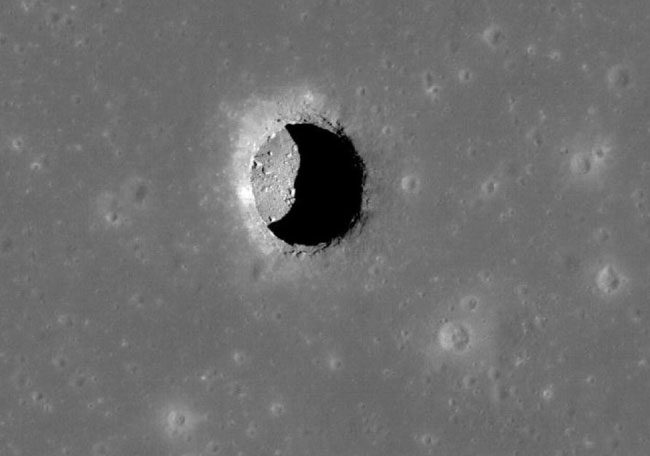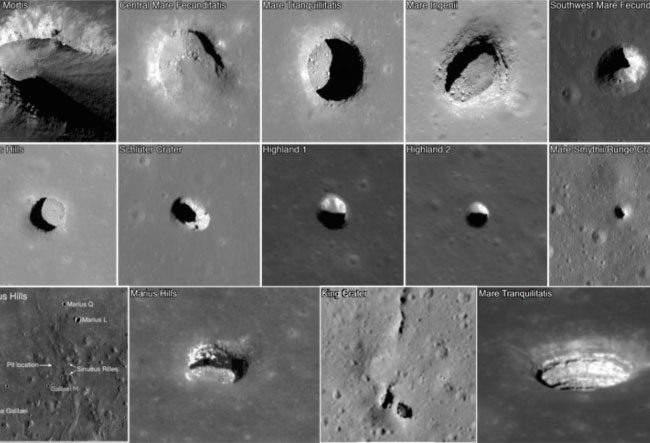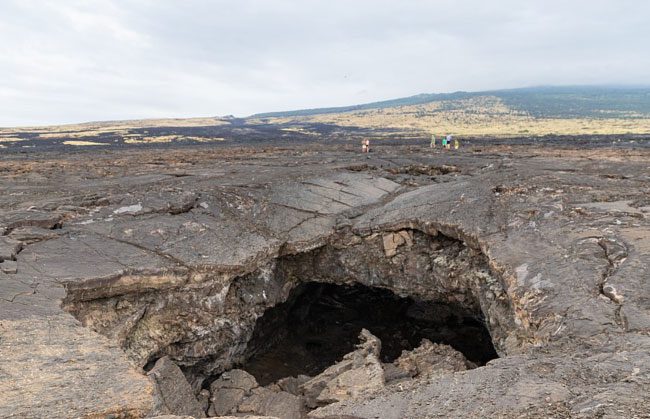The discovery of a massive lava tube near the Apollo 11 landing site is opening up the possibility of utilizing such “skylights” to establish a lunar base in the near future.
Caves have been humanity’s first shelters. Who knows what our distant ancestors thought as they sought refuge there, gathered around fires to cook meat, and drew animals on the walls? Caves protected our ancient forebears from natural elements, predators, and rivals during a time when sticks, stones, furs, and fire were our only technologies.
Thus, there is a poetic parallel between early humans and us. Today, we have visited the Moon, and the caves there could shelter us just as caves protected our ancestors on Earth.

A stunning view of a 100-meter “skylight” in the Mare Tranquillitatis region, which is a lava tube on the Moon. (Photo: NASA).
On the Moon, astronauts will need protection from various dangers. They will face cosmic and solar radiation, meteorites, sudden temperature changes, and even impacts.
The Lunar Reconnaissance Orbiter (LRO) has discovered hundreds of “skylights” on the Moon, which are collapsed lava tubes that create a natural cave opening to the planet’s surface. These lava tubes can be hundreds of meters in diameter and can be utilized to create ample living and working space, a refuge that astronauts will require. The idea is to build a permanent base within such “skylights” on the Moon.
According to El Pais, a group of Italian astronomers from the University of Trento has recently published a detailed analysis of one such “skylight” on the Moon. They estimate that the large chamber inside the cave could extend 100 meters deep beneath the surface.
In fact, lunar caves are not a new discovery. Half a century ago, Verne Oberbeck, a planetary scientist hired by NASA, proposed the existence of such structures. The first cave was identified in 2009 through images sent back by Japan’s Kaguya probe. Since then, other satellites, particularly the Lunar Reconnaissance Orbiter, have added more caves to the catalog. Today, over 200 “skylight” type caves have been discovered on the Moon.

Lava tubes could become natural shelters and bases for humans on the Moon. (Photo: NASA/universetoday).
The cave currently being studied by the Italian research team is actually a massive pit with a diameter of 45 meters. When the sun shines directly overhead, the bottom of the cave, at a depth of 150 meters, can be observed, covered in rock.
“This enormous skylight” is located in Mare Tranquillitatis, approximately 400 kilometers from where Apollo 11 landed. Its origin is believed to be due to the collapse of a lava tube, a remnant of molten material from a time long ago when the lunar plains were still young. Such formations are also found in volcanic regions on our planet.
The walls of the Tranquillitatis cave appear to have been carved out as if by a tool. Lowering a vehicle inside would require something akin to a crane. Meanwhile, other caves have slopes of about 45 degrees, too steep for wheeled rovers to navigate. However, there are alternatives: a jumping robot could comfortably explore such deep caves.
The work of the Italian astronomers is based on radar data collected by the LRO over five years ago. The data tapes used to gather information can be stored for extended periods until someone needs them for a specific study. By running various simulations, the researchers concluded that this cave could extend an additional 50 to 80 meters.
That makes it a cave the size of an Olympic swimming pool. If this is correct, it would be an excellent structure for establishing a shelter for astronauts in the future. At that depth, they would be safe from meteorite impacts, and cosmic radiation would be significantly reduced. Additionally, similar to caves on land, the minerals within would help regulate temperature fluctuations between day and night.
The authors of the study note that the accessibility of the cave and its slope hold promise for establishing a lunar base. They also emphasize that this type of formation could be very important for lunar missions, as the surface of this celestial body is extremely harsh, with temperatures ranging from 127°C to -173°C, while cosmic and solar radiation is high. Therefore, finding safe locations for infrastructure, such as these caves, is essential for sustaining exploratory operations.

Image of the entrance to a lava tube on the Big Island of Hawaii. (Photo: Wikimedia commons).
NASA has considered the possibility of establishing a base in the future by covering its walls with a thick layer of lunar regolith (dusty rock). Previously, China has also hinted at that option, but to date, no specific plans have been announced.
About six months ago, a video was leaked from the China National Space Administration, revealing details about the country’s plans to conquer the Moon. The plan mentions using magma tubes to create habitable underground modules, with structures inflated by robots lined with insulating materials. The plan also references building an orbital station around the Moon to control robotic exploration and rescue operations.
The video also discussed the possibility of drilling tunnels on the lunar surface by launching rockets from lunar orbit. This hypothesis sounds more like science fiction than reality, but we are talking about a long-term plan in which China may collaborate with Russia on launching and constructing the International Lunar Research Station in the future.
In the spring of 2023, China announced plans to begin construction of a lunar base by 2028, although it remains unclear whether this announcement referred to a lava tube-based base. This plan seems to contradict a recent statement indicating that China plans to “land astronauts on the Moon by 2030.”
But regardless of when they start, China appears committed to this idea. Ding Lieyun, a leading scientist at Huazhong University of Science and Technology, told the Chinese Science Journal that: “Ultimately, constructing residences beyond Earth is essential not only for the exploration journey of all humanity but also for China’s strategic needs as a space power.”





















































